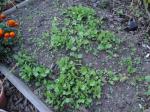I mostly like to post my recipe successes on this blog, as I’ve done this week with my series on using up excess vegetables. It’s fun to share my innovations that turn out to be good and tasty. But I suppose it might be just as useful to post my failures, so nobody will repeat my silly mistakes.
Last week, for instance, I had a lot of extra milk that had gone a little sour (still fine for cooking, but I didn’t want to use it on cereal). So I decided to make rice pudding. More to the point, I decided to make chocolate rice pudding. And then I remembered that I had gotten some fancy, exotic-looking “forbidden rice” in bulk at a health food store, so I decided to use that instead of arborio or jasmine whatever other variety one typically puts into rice pudding. Forbidden rice, if you’re not aware, is a Chinese grain that is jet black. Not just jet black, in fact, but downright inky. If you boil forbidden rice, it will turn the water purple.
I’d never cooked forbidden rice, but I thought the little black grains would be perfect in a deep, dark chocolate pudding. It would look like little cocoa nibs floating around in there! So I cooked the rice, along with milk and sugar and a vanilla bean, at a low simmer for a good long while. The milk turned a ghastly gray-purple color, but that was okay. As soon as I added the chocolate and cocoa powder, the color was a rich brown. The pudding thickened up nicely.

Looks good, right? Well, here’s what I didn’t know about forbidden rice. It never gets very soft. It’s more like wheatberries or other grains that you would use in a chewy grain salad. So I’m eating this delicious, creamy, chocolately pudding and at the same time having to chew really hard on the rice floating around in it. Not a delight.
On the plus side, all that chewing encourages slower eating. Also, I’d imagine it provides a lot more fiber than your typical rice pudding. But as much as I like the idea of dark grains in a dark pudding, I have to call this recipe a failure. Don’t try this at home!!
Read Full Post »













